Palau is a small island nation located in the western Pacific Ocean. Its geographic location and diverse habitats make it home to some of the world’s most interesting and beautiful bird species.
From colorful tropical parrots to rare migratory seabirds, the birds of Palau offer a glimpse into the unique avian life of this special corner of the world.
1. Palau Fantail
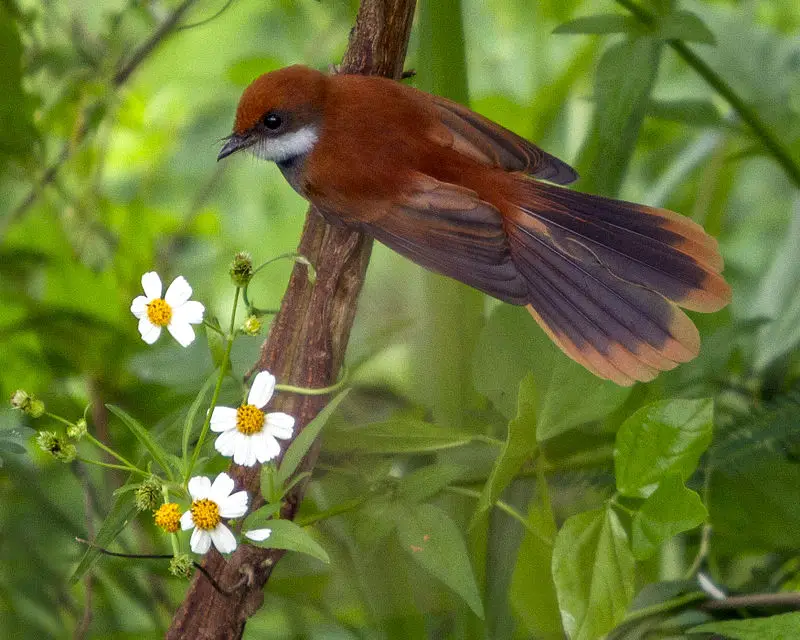
The Palau fantail (Rhipidura lepida) is an endemic bird species to the island nation of Palau. It belongs to the family Rhipiduridae and forms a superspecies with four other related birds from Indonesia, namely: long-tailed fantail of Tanimbar Islands, Sulawesi fantail of Sulawesi, tawny-backed fantail of Buru and streak-breasted fantail of Seram.
The specific name ‘lepida’ was given by its describer for its attractive features. This small passerine has white underparts with buff flanks while their upper parts are greyish brown in colour alongwith black wings having broad whitish bars on them making it visually appealing. They mainly feed on insects but sometimes also consume fruits like figs as well.
These birds inhabit dense forests close to water sources where they build nests near streams or ponds; often placing them low among trees so that they can easily take off when disturbed or chased away by predators such as snakes or crows etceteraScientific classification:
| Kingdom | Animalia |
| Phylum | Chordata |
| Class | Aves |
| Order | Passeriformes |
| Family | Rhipiduridae |
| Genus | Rhipidura |
| Species | R. lepida |
2. Palau Ground Dove
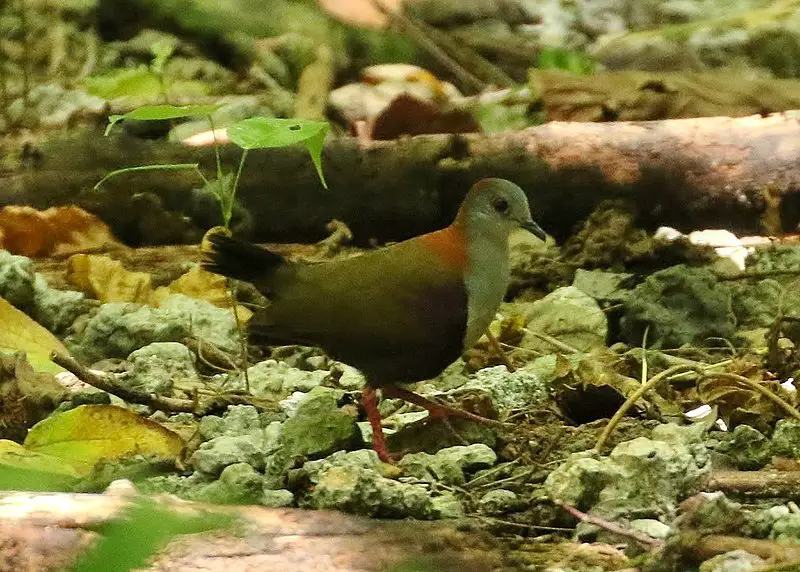
The Palau ground dove is an endangered bird species endemic to the island of Palau. It lives in forests and can be identified by its grayish-brown feathers, dark brown crown and a black tail with white edges.
Its wings are short but strong enough for quick flight maneuvering. The IUCN has assessed this species as Endangered due to habitat destruction caused by human activities such as agricultural expansion, logging and residential development.
Hartlaub and Finsch first described it in 1872 under the name Phlegoenas canifrons which was later moved to Alopecoenas genus making it monotypic today.
Conservation efforts should be taken immediately if we want future generations to still get a chance at seeing these beautiful birds in their natural habitats.Scientific classification:
| Kingdom | Animalia |
| Phylum | Chordata |
| Class | Aves |
| Order | Columbiformes |
| Family | Columbidae |
| Genus | Pampusana |
| Species | P. canifrons |
3. Palau Flycatcher
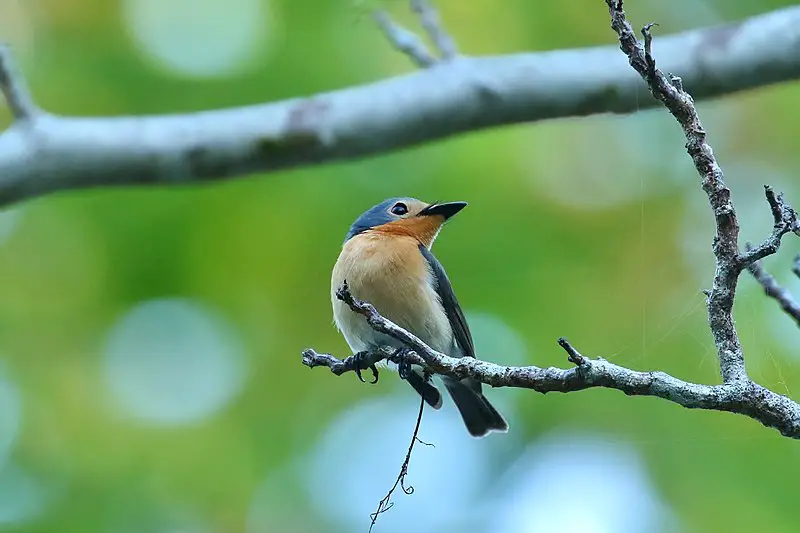
The Palau flycatcher is a species of bird found exclusively in the island country of Palau. It belongs to the family Monarchidae and may be considered by some authorities as a subspecies of oceanic flycatcher.
Commonly referred to with alternate names such as mangrove, Micronesian broadbill, or rufous-faced Myiagra flycatcher, it has an overall brown plumage and distinct reddish facial markings that set it apart from other birds in its genus.
The palau Flyctacher prefers coastal habitats such as beaches and estuaries due to its primarily fish diet but can also occasionally be seen foraging on land near streams or rivers for insects.
As habitat destruction continues this endemic species faces increasing risk of population decline making conservation efforts paramount for their future survival.Scientific classification:
| Kingdom | Animalia |
| Phylum | Chordata |
| Class | Aves |
| Order | Passeriformes |
| Family | Monarchidae |
| Genus | Myiagra |
| Species | M. erythrops |
4. Morningbird
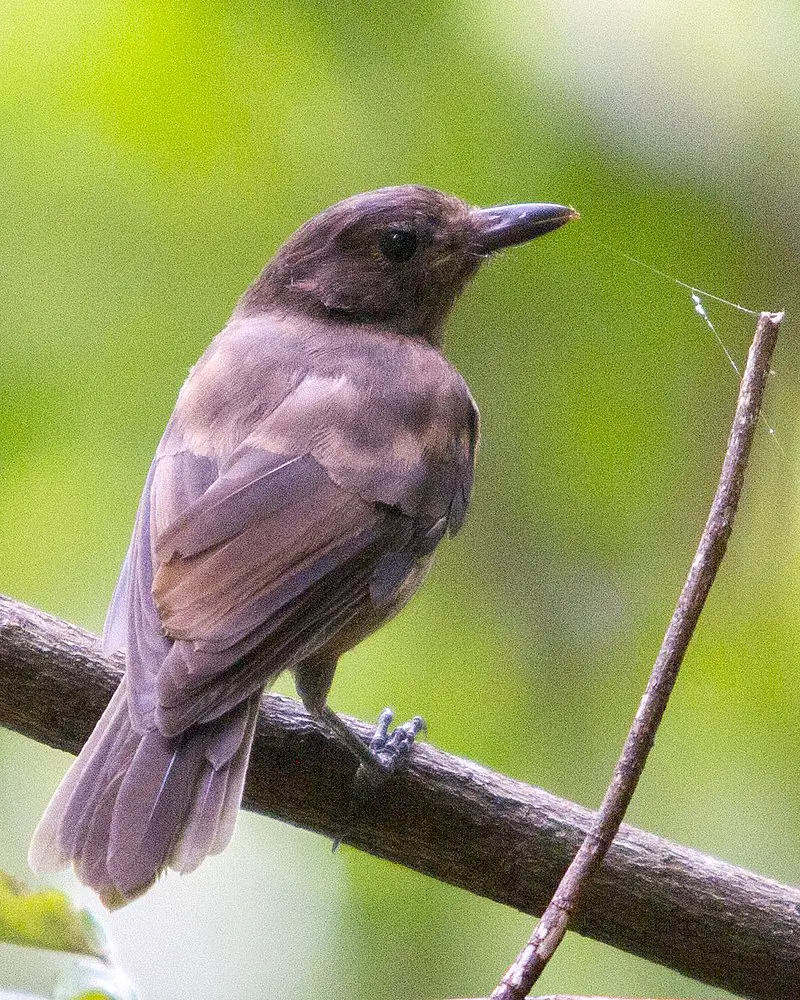
The Morningbird is a species of songbird belonging to the family Pachycephalidae. It has an impressive range, stretching from Eastern and Central Australia all the way through Southeast Asia into Indonesia and New Guinea.
Its plumage is mostly greyish-brown with black barring on its wings and tail feathers. The male also sports yellow spots near his throat area as well as some patches of red crown feathers along the top of his head, making it quite distinct from other similar birds in its genus.
This bird prefers habitats such as woodlands, forests or grassy areas where they can find plenty of insects to eat while singing their melodious songs early in the morning hours when they are most active – hence earning them their name.Scientific classification:
| Kingdom | Animalia |
| Phylum | Chordata |
| Class | Aves |
| Order | Passeriformes |
| Family | Pachycephalidae |
| Genus | Pachycephala |
| Species | P. tenebrosa |
5. Palau Bush Warbler
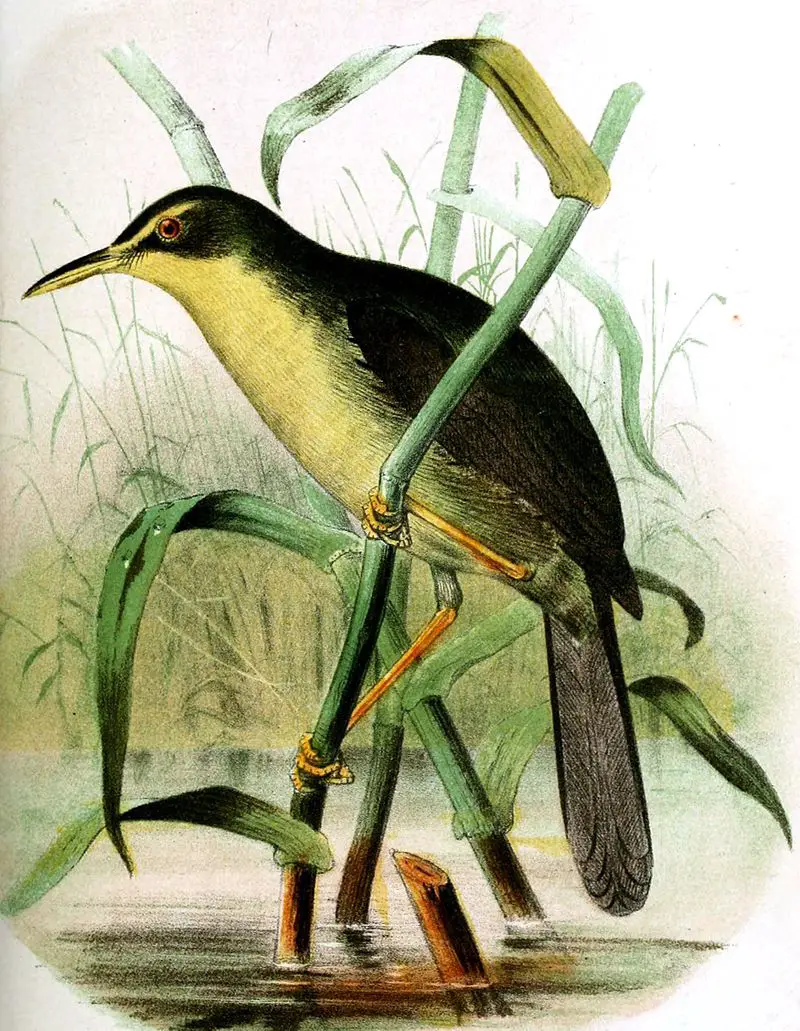
The Palau bush warbler is a bird found only in the island country of Palau. It belongs to the Old World Warblers family, Cettiidae. Its plumage is mainly dark brown and its head has lighter coloration with some yellow feathers on its nape.
The wings are short and rounded while it’s tail is fairly long compared to other birds of similar size.
This species feeds primarily on insects, fruits, seeds and various invertebrates making up most of their diet when available during different seasons throughout the year.
The breeding season usually starts by late April or early May depending upon availability of food sources for them as well as suitable nesting sites near water bodies such as rivers or lakes where they can find ample supply of aquatic prey items like snails etcetera which serves as an important component in their diet during this period especially for raising young ones successfully.Scientific classification:
| Kingdom | Animalia |
| Phylum | Chordata |
| Class | Aves |
| Order | Passeriformes |
| Family | Cettiidae |
| Genus | Horornis |
| Species | H. annae |
6. Megapode
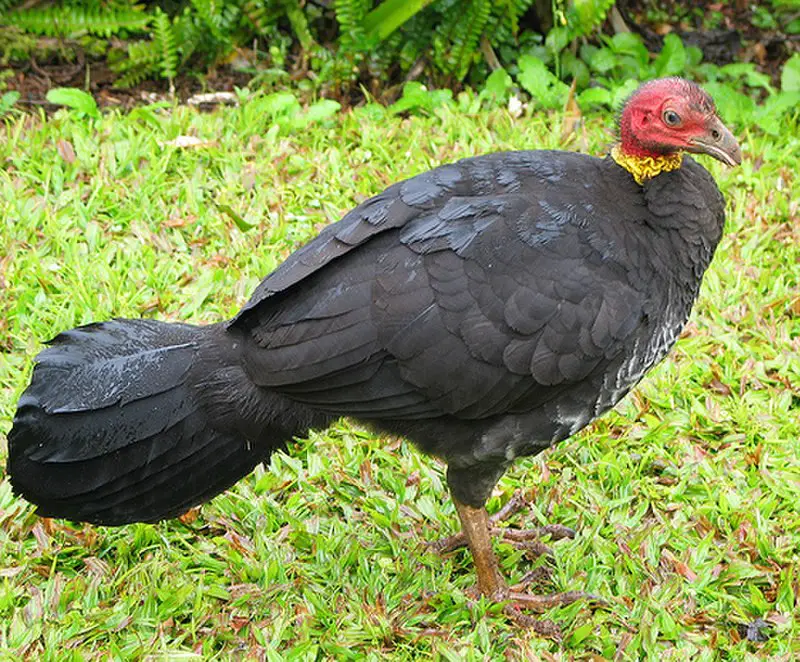
Megapodes are a unique family of birds with large feet and small heads. They measure from medium-large in size, similar to chickens, and have either brown or black feathers covering their bodies.
These terrestrial creatures live mainly in wooded areas where they browse for food like fruits and insects.
With the exception of the Malleefowl species, all Megapodes build mounds which act as incubators for them to lay eggs on – hence why they’re also known as “incubator birds”.
Thanks to this adaptation, these unusual animals can survive extreme temperatures by relying on heat generated from composting material beneath them instead of sitting directly atop their eggs.Scientific classification:
| Kingdom | Animalia |
| Phylum | Chordata |
| Class | Aves |
| Order | Galliformes |
| Family | Megapodiidae Lesson, 1831 |
7. Palau Fruit Dove
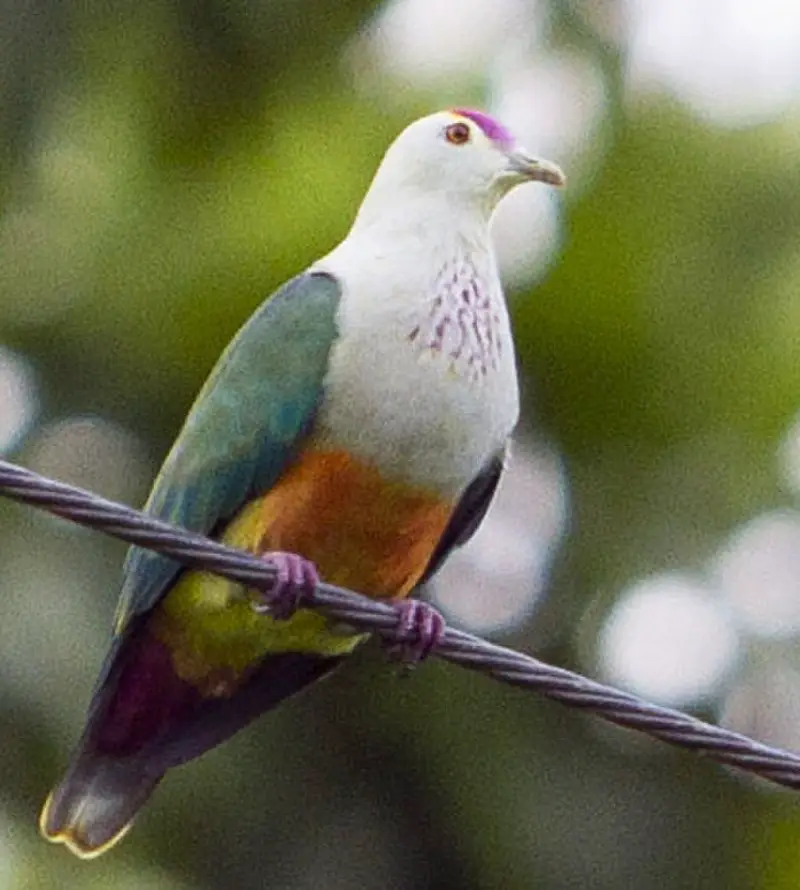
The Palau fruit dove is a species of bird that is endemic to the islands of Palau. It has been named as the national bird and stands at approximately 23-25 cm tall with an average weight of 93 grams.
Its feathering consists primarily of grey, purple and yellow colours along with an orange band across its lower breast area. On top it sports olive green back wings leading down to black tail feathers which are tipped in white for added contrast.
The beak on this pigeon is short and curved allowing them feed efficiently from fruits found within their native range such as figs or mangos.
They have also adapted well to live among humans in urban areas but prefer natural forest habitats when available due to less competition for food sources.
Overall, the Palau Fruit Dove makes a beautiful addition both visually and audibly through their melodic cooing sounds they make while flying around seeking out ripe fruits.Scientific classification:
| Kingdom | Animalia |
| Phylum | Chordata |
| Class | Aves |
| Order | Columbiformes |
| Family | Columbidae |
| Genus | Ptilinopus |
| Species | P. pelewensis |
8. White-Breasted Woodswallow
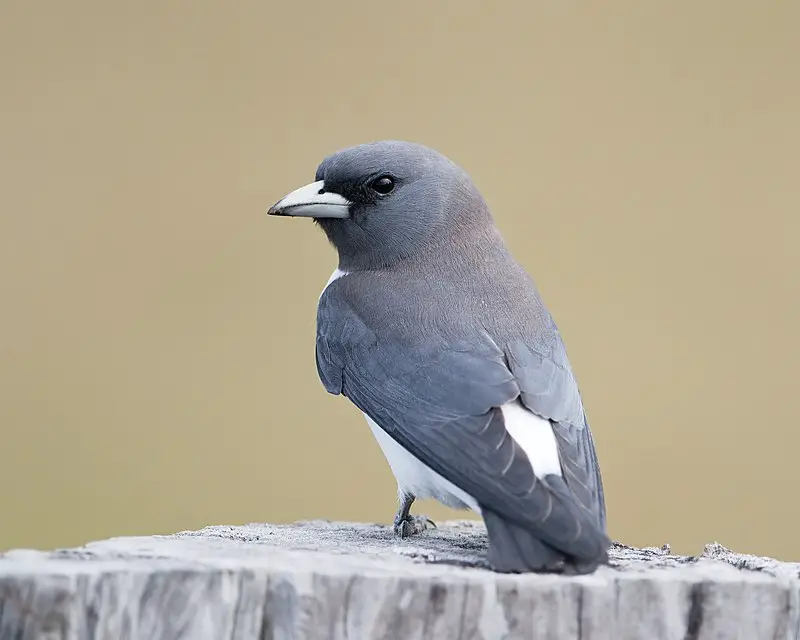
The White-breasted Woodswallow is a medium-sized passerine bird found in the Andaman Islands, Indonesia and Northern Australia.
Its name may be misleading as it does not belong to the family of true swallows but rather belongs to Artamidae which also includes butcherbirds, currawongs and Australian magpie.
These birds are mainly greyish brown with white belly patch and long wings having two pale bars on them.
They feed on insects like ants, beetles etc., captured from foliage or air during flight.
Breeding season for this species starts from October till December when they build their cup shaped nests out of twigs near tree trunks or branches usually high up in trees for protection against predators such as snakes or raptors.
Male woodswallows can often been seen singing loudly while displaying its aerial maneuvering capabilities trying to attract potential mates.Scientific classification:
| Kingdom | Animalia |
| Phylum | Chordata |
| Class | Aves |
| Order | Passeriformes |
| Family | Artamidae |
| Genus | Artamus |
| Species | A. leucorynchus |
9. Micronesian Megapode
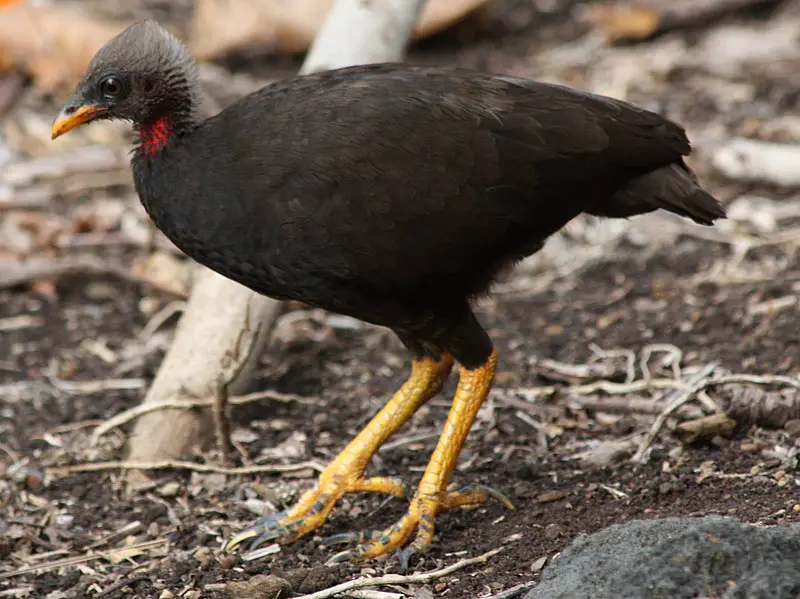
The Micronesian Megapode is an endangered bird species inhabiting the islands of the Western Pacific Ocean. It has a stocky body, mostly dark brown-black in colour with its head being paler than its body.
The crest is grey, bill yellow and legs and feet dull-yellow. Its length from beak to tail tip measures 38cm making it medium sized for a megapode bird.
Their diet consists mainly of fruits, nuts and invertebrates found on the forest floor which they locate by their well developed sense of smell as opposed to sight or hearing like other birds do.
To breed they make mounds out of soil where females lay around twenty eggs at once that are then incubated by the heat generated from decomposing organic matter within them.Scientific classification:
| Kingdom | Animalia |
| Phylum | Chordata |
| Class | Aves |
| Order | Galliformes |
| Family | Megapodiidae |
| Genus | Megapodius |
| Species | M. laperouse |
10. Micronesian Myzomela
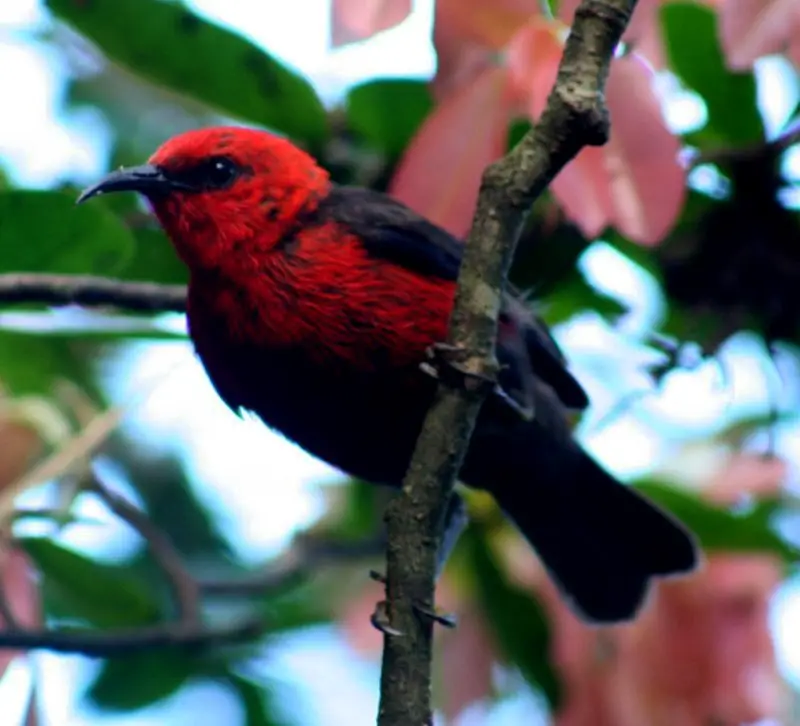
The Micronesian myzomela is a species of bird in the honeyeater family Meliphagidae, which is composed of seven insular subspecies distributed throughout the Northern Mariana Islands, including Rota, Tinian and Saipan.
This species forms part of a superspecies with other related island and mainland myzomelas across Pacific Ocean and Australia.
It has distinctive black plumage on its upperparts as well as bright yellow underparts that make it easily recognisable.
The bill shape varies slightly between subspecies but generally these birds have short curved bills adapted for nectar extraction from flowers.
These birds feed mainly on insects caught during sallies from an exposed perch or directly gleaned off foliage while also consuming nectar from flowering trees such as Hibiscus tiliaceus.Scientific classification:
| Kingdom | Animalia |
| Phylum | Chordata |
| Class | Aves |
| Order | Passeriformes |
| Family | Meliphagidae |
| Genus | Myzomela |
| Species | M. rubratra |
11. Palau Swiftlet
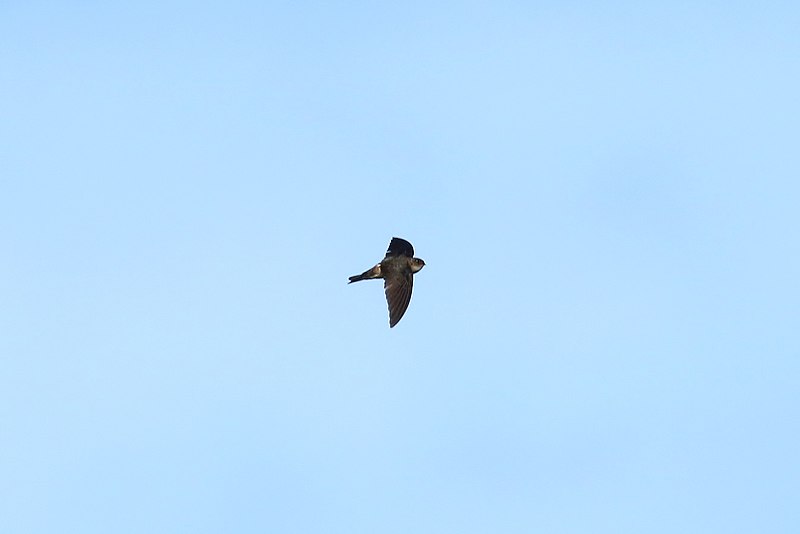
The Palau swiftlet is a species of small bird endemic to the island nation of Palau. It belongs to the family Apodidae and its natural habitat is lowland forests with moist climates.
These birds are dark brown in color, have short wings, long tails, and measure up to 8 inches in length.
They also possess very good eyesight which allows them to catch flying insects while they’re on the wing as their primary food source.
Despite being an endangered species due primarily to deforestation, it has managed so far not become extinct thanks largely due efforts from conservationists who are aiming at preserving this rare species for future generations.Scientific classification:
| Kingdom | Animalia |
| Phylum | Chordata |
| Class | Aves |
| Order | Apodiformes |
| Family | Apodidae |
| Genus | Aerodramus |
| Species | A. pelewensis |
12. Blue-Faced Parrotfinch
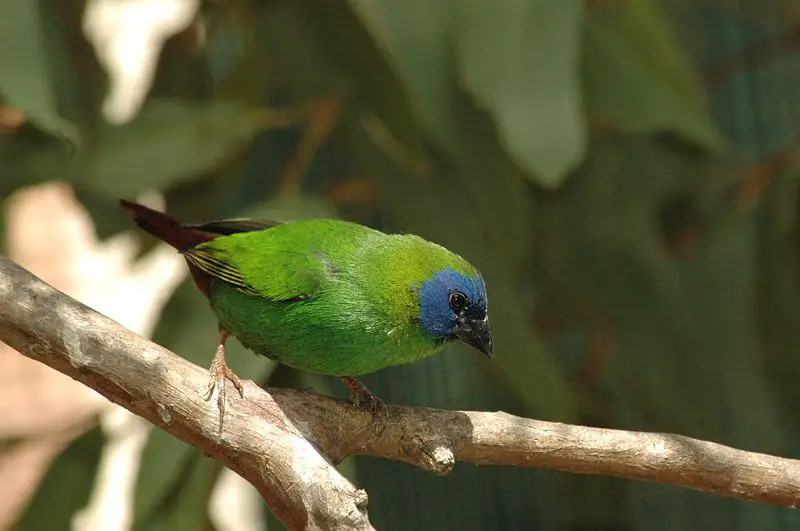
The Blue-faced Parrotfinch is a species of estrildid finch found all across the Pacific, from Australia to Japan and beyond.
It has an estimated global range of 10 million km2, inhabiting subtropical and tropical areas in both mountainous regions and lowland forests.
Its plumage is predominantly blue with white markings on its face as well as some yellow spots or stripes on its wings and tail.
The bird feeds mainly on insects but also eats seeds and fruits when available.
Breeding usually occurs during the rainy season; males construct nests lined with grasses while females lay up to five eggs at once which they incubate for two weeks until hatching takes place.
This species is considered locally common throughout most parts of their distribution area although no population estimates are currently available due to difficulties assessing them over large distances.Scientific classification:
| Kingdom | Animalia |
| Phylum | Chordata |
| Class | Aves |
| Order | Passeriformes |
| Family | Estrildidae |
| Genus | Erythrura |
| Species | E. trichroa |
13. Micronesian Starling
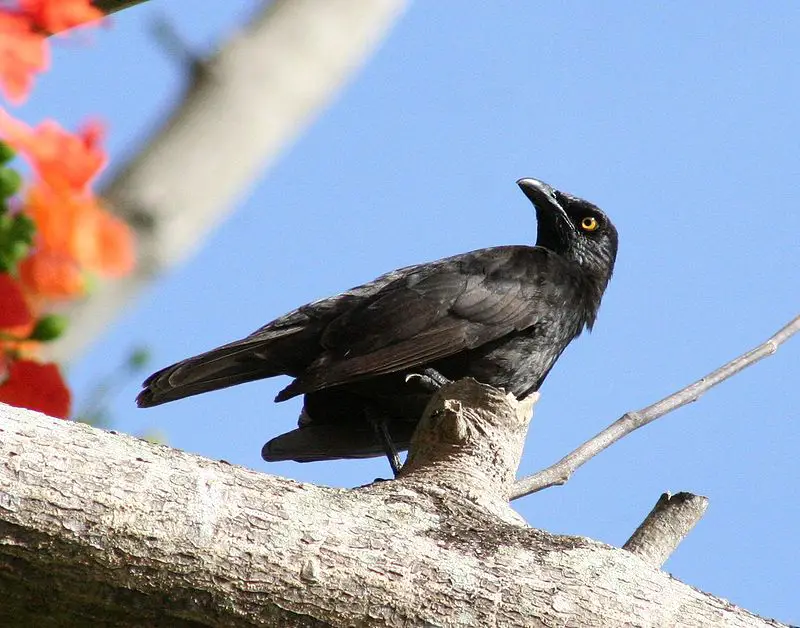
The Micronesian starling is a species of starling found in subtropical or tropical dry and moist forests across Micronesia, the Northern Mariana Islands, and Palau.
It has an impressive range for such a small bird. They are quite bold around humans as well. Diet-wise, they mainly consume fruit, seeds and occasionally insects; seabird eggs make up part of their diet too.
These birds are social creatures often seen congregating in large flocks near food sources like fruiting trees or bodies of water with plenty of aquatic invertebrates to feast on.
Their plumage consists mostly of shades grey although some may have faint hints blue/green iridescence depending on lighting conditions prevailing during the day.
Overall these beautiful little birds provide much joy when sighted in the wild.Scientific classification:
| Kingdom | Animalia |
| Phylum | Chordata |
| Class | Aves |
| Order | Passeriformes |
| Family | Sturnidae |
| Genus | Aplonis |
| Species | A. opaca |
14. Common Cicadabird
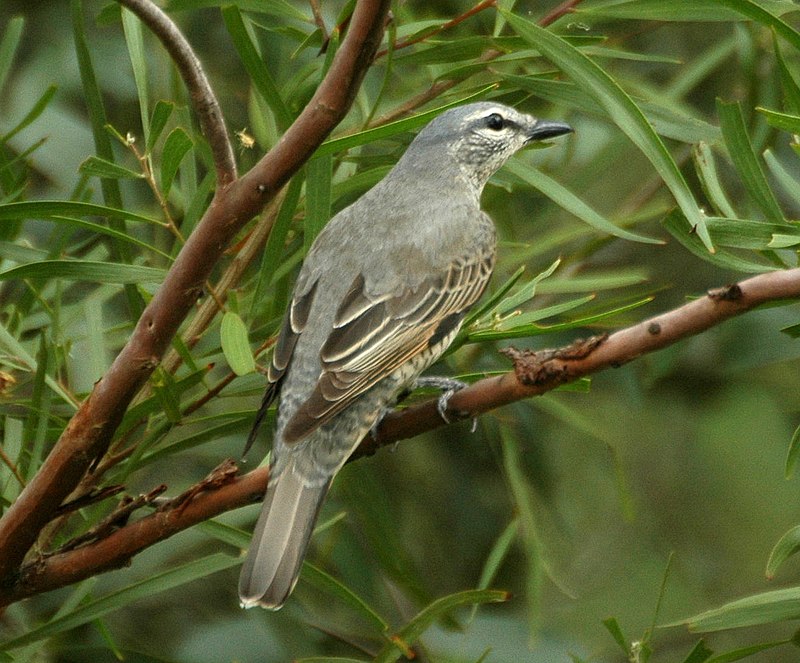
The Common Cicadabird is a species of bird found in Australia, Indonesia, New Guinea and the Solomon Islands. It typically inhabits temperate forest or subtropical moist lowland forests.
This slender-billed bird has olive green upperparts with white streaking on its back and wings and yellow under parts with some dark barring on its breast.
Its song consists of loud cicada like calls that can be heard from up to several hundred meters away.
The common cicadabird feeds primarily on insects such as caterpillars, grasshoppers and beetles which it catches by sallying out from an exposed perch before returning to the same spot once again.
Overall this small passerine makes for an interesting addition to any local wildlife area.Scientific classification:
| Kingdom | Animalia |
| Phylum | Chordata |
| Class | Aves |
| Order | Passeriformes |
| Family | Campephagidae |
| Genus | Edolisoma |
| Species | E. tenuirostre |
Also Featured In: Birds that Live in Sunshine Coast, Common Townsville Birds
15. Dusky White-Eye
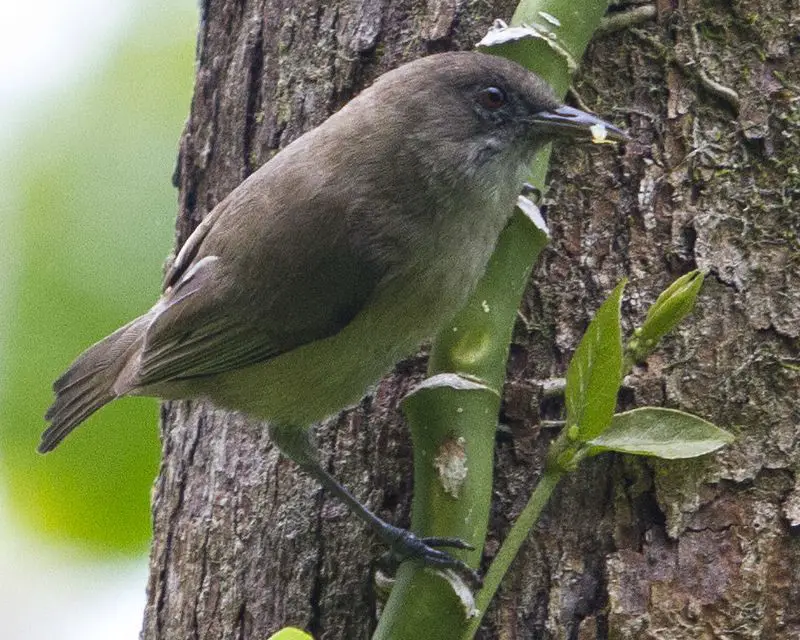
The dusky white-eye is a beautiful bird native to Palau. It belongs to the family Zosteropidae and has a unique plumage of dark feathers with bright yellow patches on its wings, head and tail.
Its natural habitat consists of subtropical or tropical moist lowland forests where it can be found foraging in small flocks for food such as insects and fruit.
This species is not currently threatened but deforestation could endanger these birds if their habitats continue to shrink due to human activities.
The conservation status of this species should be monitored closely so that appropriate measures can be taken if needed in order protect them from extinction.Scientific classification:
| Kingdom | Animalia |
| Phylum | Chordata |
| Class | Aves |
| Order | Passeriformes |
| Family | Zosteropidae |
| Genus | Zosterops |
| Species | Z. finschii |
16. Red-Tailed Tropicbird
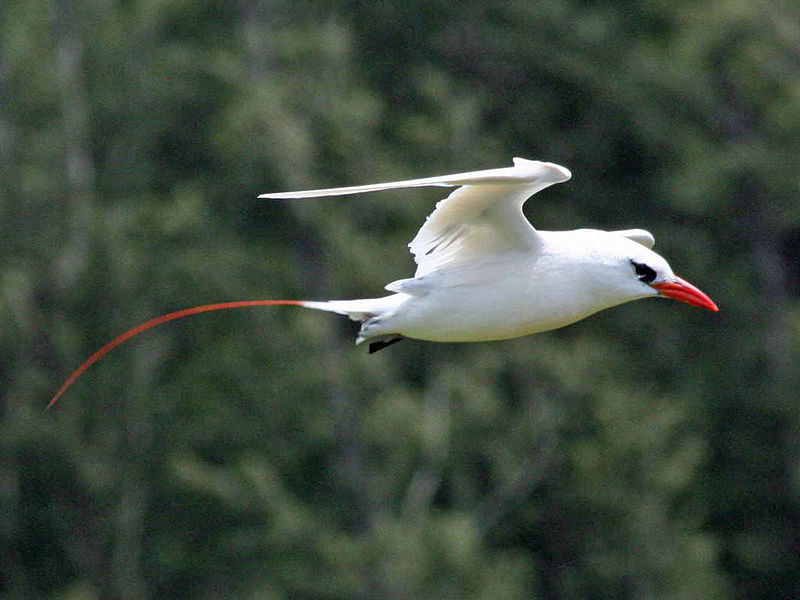
The Red-tailed Tropicbird is an exotic seabird found in tropical areas of the Indian and Pacific Oceans. It has a striking appearance, with mostly white feathers and a black mask covering its eyes.
Its bill is bright red, making it stand out against its pale plumage. Both males and females have similar looks to one another – unlike many other birds species where the male looks significantly different from that of the female.
Described by Pieter Boddaert in 1783, this impressive bird can be seen soaring through tropical skies looking for food either alone or within small flocks made up of several individuals at once.Scientific classification:
| Kingdom | Animalia |
| Phylum | Chordata |
| Class | Aves |
| Order | Phaethontiformes |
| Family | Phaethontidae |
| Genus | Phaethon |
| Species | P. rubricauda |
17. Citrine White-Eye
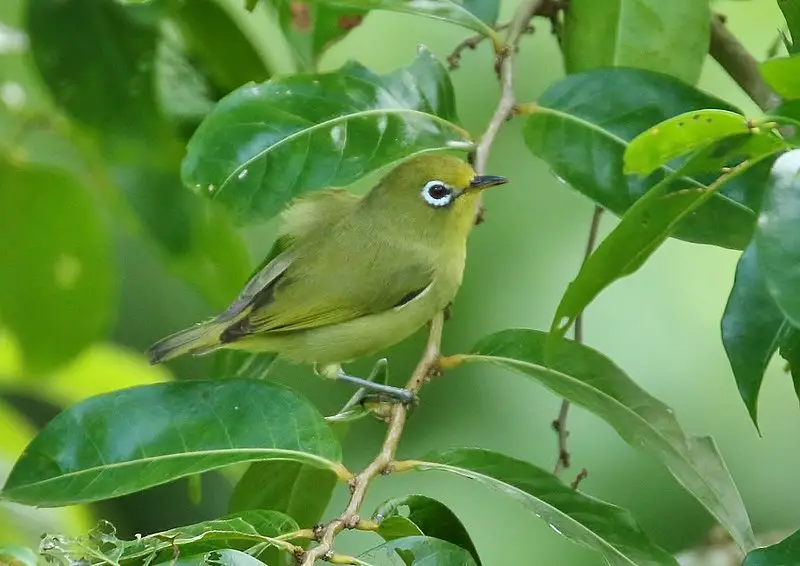
The Citrine white-eye, also known as the Caroline Islands White-eye, is a species of bird belonging to the Zosteropidae family. It inhabits Palau and Federated States of Micronesia in Oceania.
This small passerine bird has an olive green body with yellowish wings and tail feathers, along with a distinct yellow eye ring around its black eyes.
The male birds have whitish underparts while those of females are browner in coloration.
They forage for food among foliage or on tree trunks during daylight hours; their main diet consists of insects such as beetles and ants which they catch by gleaning from leaves or hovering midair before picking them off branches or other surfaces.
These active little birds can often be seen flitting about amongst trees in pairs or large groups.Scientific classification:
| Kingdom | Animalia |
| Phylum | Chordata |
| Class | Aves |
| Order | Passeriformes |
| Family | Zosteropidae |
| Genus | Zosterops |
| Species | Z. semperi |
18. Micronesian Imperial Pigeon
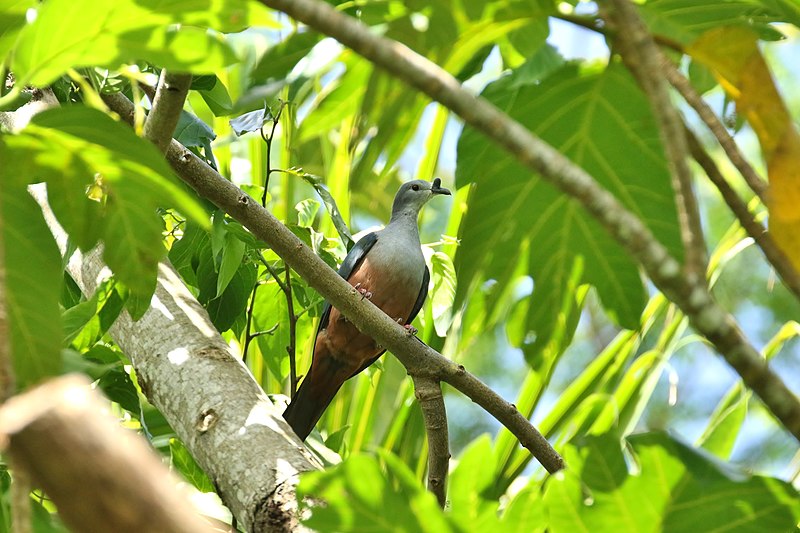
The Micronesian imperial pigeon is a bird species found in Palau, the Caroline Islands, the Marshall Islands and Nauru.
It has various habitats such as montane forests, secondary forests, beach-side forests and mangroves.
Unfortunately this beautiful creature is threatened by hunting and deforestation due to human activities. The IUCN have assessed it with “Near Threatened” status for its conservation priority levels.
This large sized bird can be seen flying around during dusk or dawn time periods in search of food like fruits from trees close by their habitat locations.
If we are able to protect its natural environment then this magnificent specie will continue living peacefully without any disturbances while appreciating nature’s beauty.Scientific classification:
| Kingdom | Animalia |
| Phylum | Chordata |
| Class | Aves |
| Order | Columbiformes |
| Family | Columbidae |
| Genus | Ducula |
| Species | D. oceanica |
19. Slaty-Legged Crake
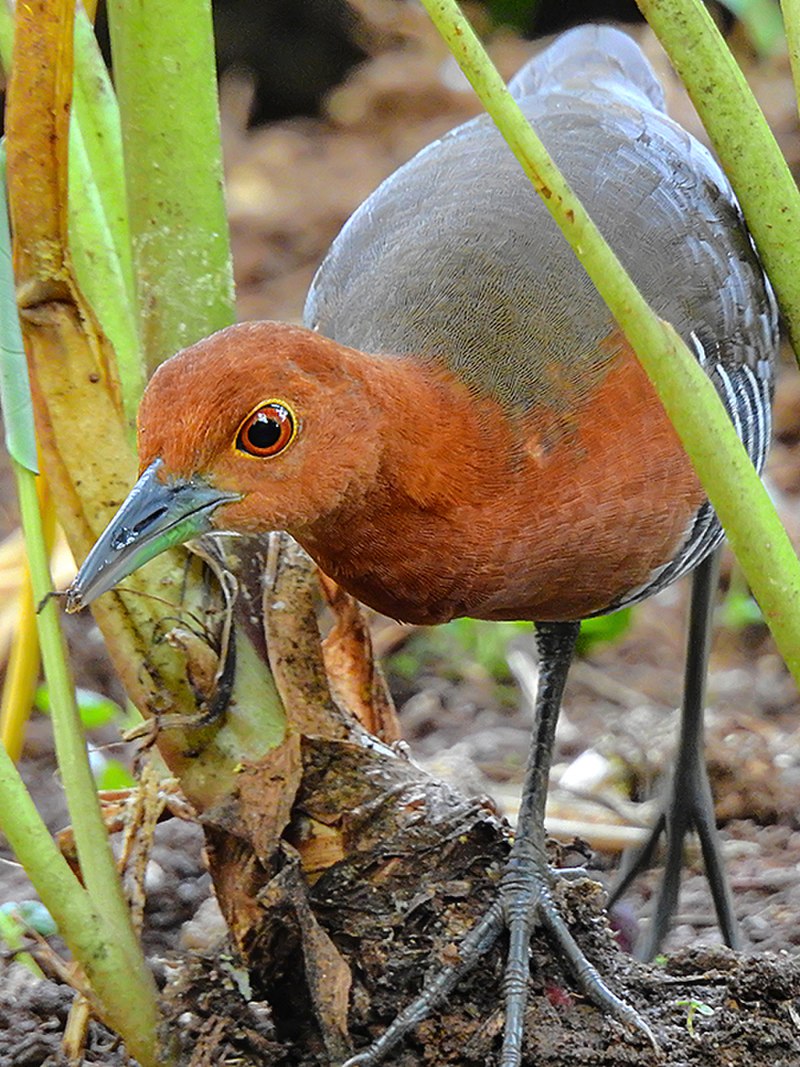
The Slaty-legged Crake is a waterbird in the rail and crake family found across south Asia. It inhabits swamps, wetlands and well-wooded areas from India to Indonesia.
This species can be identified by its mottled grey coloration on their legs and wings as well as their bright red eyes. These birds are mainly permanent residents but some of them migrate further north during certain seasons.
They feed mostly on aquatic invertebrates such as insects, larvae, worms etc among other things including small fish or amphibians when available.
The female lays one clutch with 4-7 eggs per season which she incubates for 16 days before they hatch out into younglings who leave the nest within 2 weeks after hatching.
Their calls consist of low whistles which makes it difficult to spot them unless you know what to look for.Scientific classification:
| Kingdom | Animalia |
| Phylum | Chordata |
| Class | Aves |
| Order | Gruiformes |
| Family | Rallidae |
| Genus | Rallina |
| Species | R. eurizonoides |
20. Red-Footed Booby
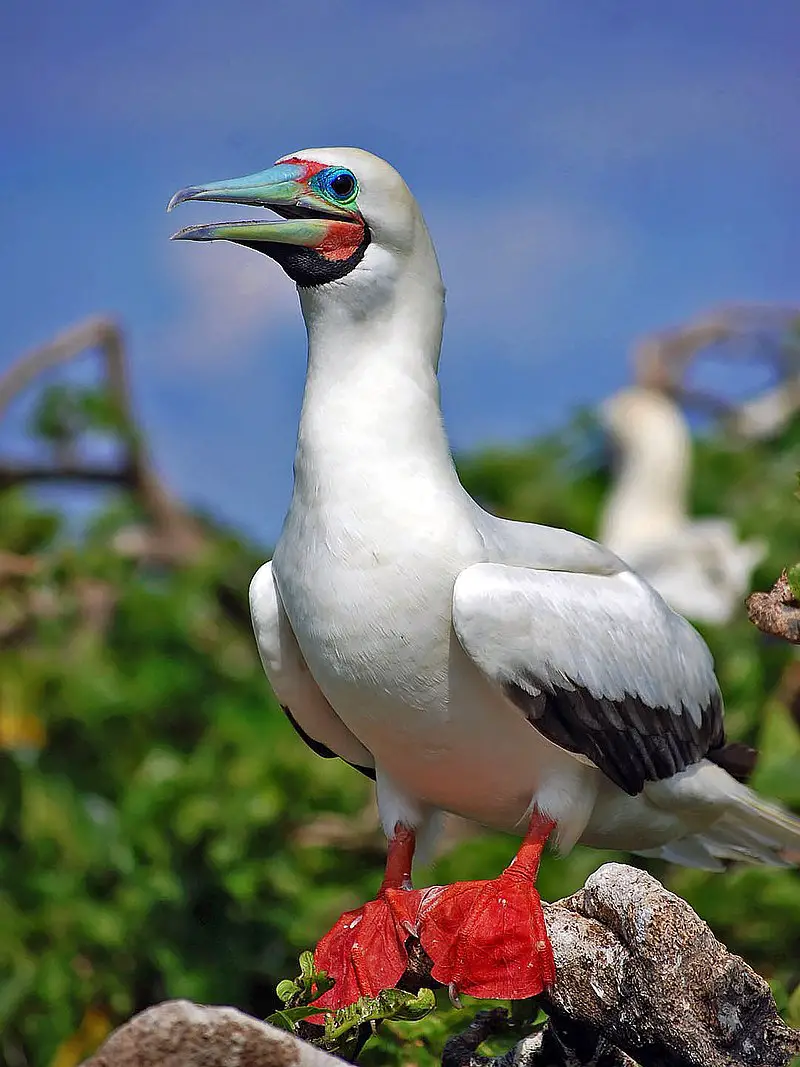
The Red-footed Booby is a large seabird of the Sulidae family, easily distinguished by its bright red feet. These birds are strong and agile fliers but can be clumsy in takeoffs and landings.
They live mostly in tropical areas and breed colonially on coastal islands all over the world.
The species faces few threats from either nature or humans, however their population has decreased slightly due to disturbances near breeding sites.
Despite this mild decline, they remain an incredibly common sight across many parts of the tropics – so much so that they have become symbolic with island life.Scientific classification:
| Kingdom | Animalia |
| Phylum | Chordata |
| Class | Aves |
| Order | Suliformes |
| Family | Sulidae |
| Genus | Sula |
| Species | S. sula |
21. Streaked Shearwater
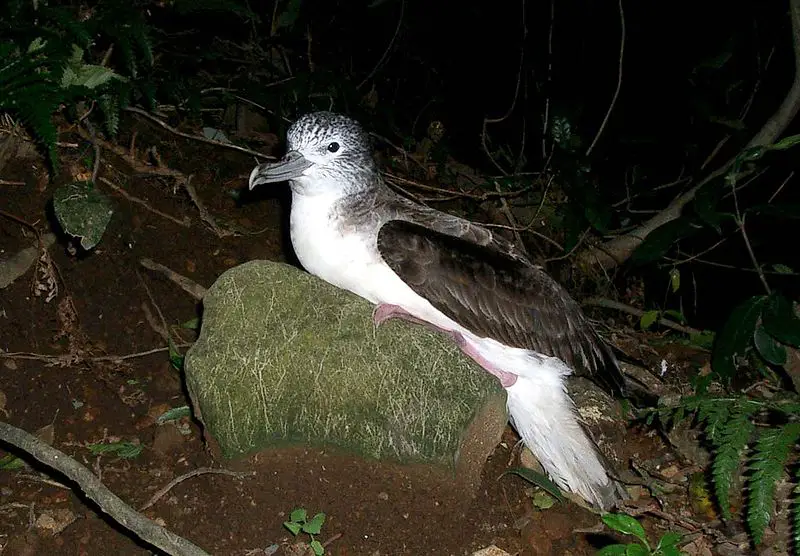
The Streaked Shearwater is a species of seabird that averages 48 cm in length and has a wingspan of 122 cm. It primarily feeds on fish, squid, and anchovy crawls off Japan.
Sadly it can often be taken as by-catch in nets or die from ingesting bait from longline fishing lines. This bird may also follow fishing boats to scavenge for food scraps thrown overboard.
Despite its vulnerability to human activity, the Streaked Shearwater’s population numbers have remained stable due to its wide range across many oceanic regions such as the North Pacific Ocean and South China Sea.Scientific classification:
| Kingdom | Animalia |
| Phylum | Chordata |
| Class | Aves |
| Order | Procellariiformes |
| Family | Procellariidae |
| Genus | Calonectris |
| Species | C. leucomelas |
Also Featured In: Birds that Can Survive in the Storm, Native Birds Of Kuchinoerabu Island
22. Oriental Plover
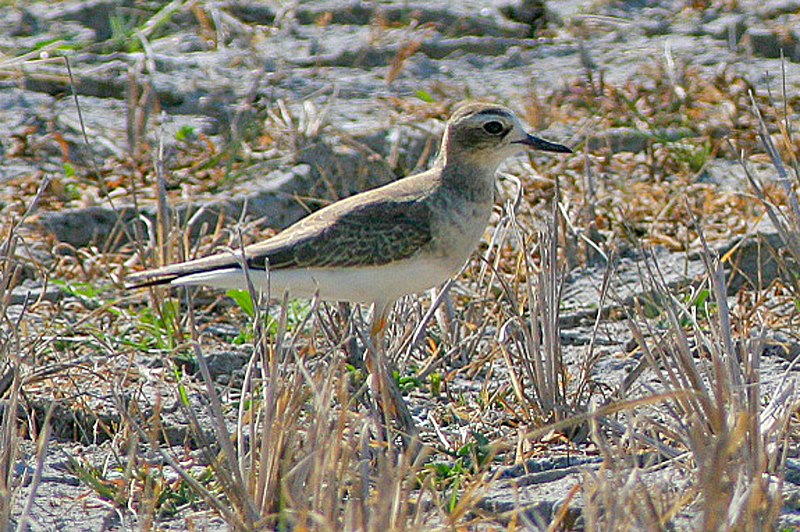
The Oriental Plover is a medium-sized bird that belongs to the family Charadriidae. It has striking plumage with white faces, throats and fore-crowns while grey brown hind-crowns, hind necks and napes are seen on their backs.
These birds breed in parts of China and Mongolia during springtime before migrating southwards towards Indonesia, New Guinea as well as northern Australia for non-breeding season in autumn.
They feed mainly on insects which they pick from mudflats or ploughed fields but may also eat worms or small crustaceans occasionally.
Believed to be monogamous creatures by nature, these birds form long term pair bonds leaving them vulnerable when one mate dies due to natural causes like old age or predation by predators such as hawks and foxes etc.
Despite being listed under ‘Least Concern’ category by IUCN Red list due to stable population numbers across its range; habitat degradation caused by human activities still threatens it survival rates significantlyScientific classification:
| Kingdom | Animalia |
| Phylum | Chordata |
| Class | Aves |
| Order | Charadriiformes |
| Family | Charadriidae |
| Genus | Charadrius |
| Species | C. veredus |
23. Pacific Long-Tailed Cuckoo
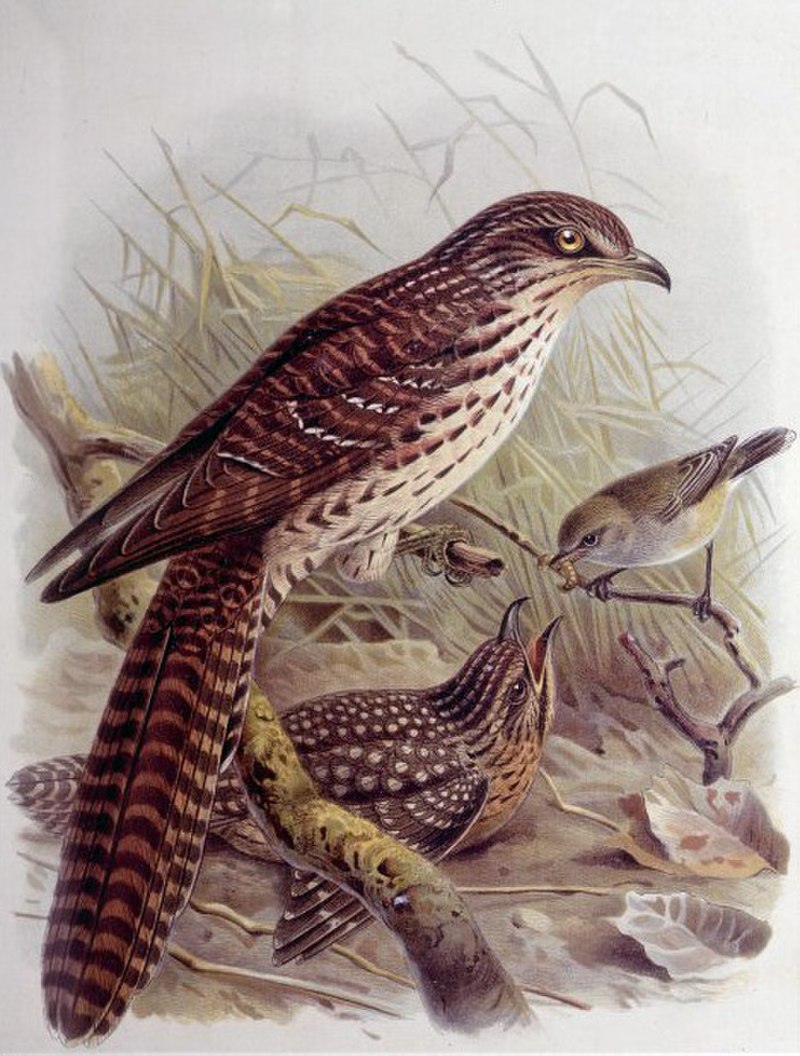
The Pacific long-tailed cuckoo is a species of bird from the Cuculidae family. It is found only in New Zealand, where it breeds during spring and summer before migrating to various Pacific islands for its winter season.
This bird has many names such as sparrow hawk, home owl, screecher or koekoeā in Māori.
The most distinctive feature about this species are their elongated tails which can measure up to 16 cm long.
They are also brood parasites meaning they will lay eggs in other birds’ nests then rely on them to raise their young without any parental help from themselves.
Despite these traits however, they still make beautiful additions to our avian population with their melodious calls that echo through the forests each morning and night.Scientific classification:
| Kingdom | Animalia |
| Phylum | Chordata |
| Class | Aves |
| Order | Cuculiformes |
| Family | Cuculidae |
| Genus | Urodynamis Vigors & Horsfield, 1826 |
| Species | U. taitensis |